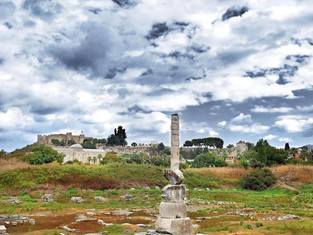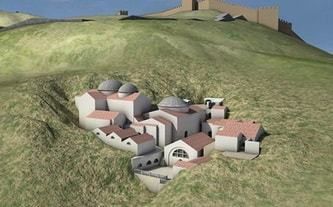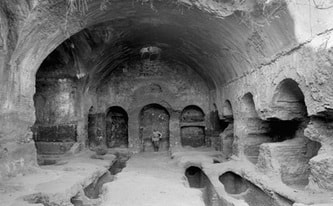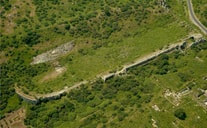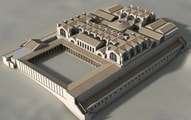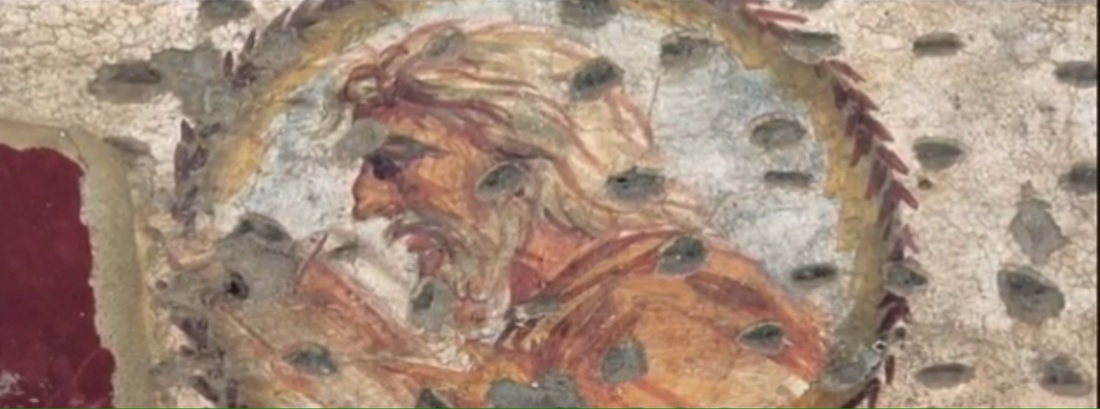 RSS Feed RSS Feed
The Temple of Artemis, One of the Seven Wonders of the Ancient World is among the most important historic sights around Ephesus, rebuilt at least five times, the Temple offered Sanctuary to those who took Refuge here.
Artemis Temple is located around 1,5 kms. inland from Ephesus Ancient City. The location was one of the former settlements of Ephesus. 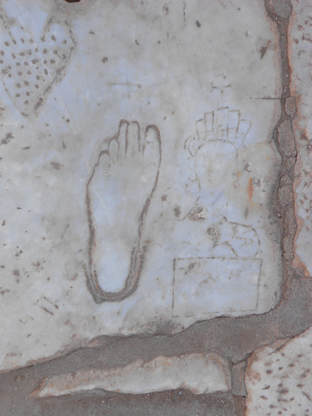 "The Foot Sign" carved on the sidewalk in Ephesus "The Foot Sign" carved on the sidewalk in Ephesus
One of the top interesting spots for visitors of Ephesus that still keeps its mystery is the so called House of Pleasure or the Love House.
One would have hard time not to the realize the promiscuous laughs of the visitors who are on their Private Tour of Ephesus listening the commentaries of their Private Tour Guide for Ephesus about this attraction. 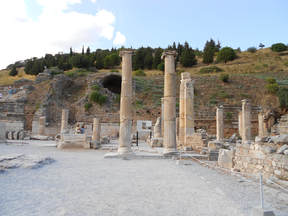
Basilica Stoa bordered the north side of the State Agora donated to the city by it's own rich citizen C. Sextilius Pollio and his family, it was built in 11 AD.
During it's day it was considered to be one of the most magnificent buildings in Ephesus. It was built with 2 storeys and 3 Aisles. Access to the Basilica was obtained by 4 steps from the Agora Area and 2 entrances on either side of the structure. 12 years after it's completion, the city was hit by an earthquake. During repairs the number of columns was almost doubled to give the structure more strength.
If you are looking to book a Private Ephesus Tour including The Temple of Artemis You can click here to Contact Us

Ephesus Archaeological Museum is located in the town of Selcuk only about 2 kms. distance to the Ancient City of Ephesus. The Museum has a great exhibit of the Finds from the Excavations held in Ephesus for the last 130 years. A Tour of Ephesus is never complete without seeing the Archaeological Museum of Selcuk. 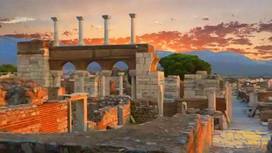
Basilica that was built by Byzantine Emperor Justinian for the name of St. John in 6th Century AD is located on Ayasuluk hill.
There was a small Monastery chapel built in the Late 4th century or Early 5th Century AD. Ayasuluk Hill was one of the former settlements of Ephesus, and it has been inhabited by some of the early Christian communities of Ephesus that must have built this early monastery and the Chapel in the memory of St. John the Evangelist.
In its time it was the 7th largest Cathedral in the World.
If you are looking to book a Private Ephesus Tour including The Temple of Artemis You can click here to Contact Us
The Church was an important Pilgrimage Spot starting from 7th Century AD.
Many European pilgrims paid a visit to Ephesus and Basilica of St. John along their route to Jerusalem.
The Basilica was built by structural pieces obtained from Ephesus Ancient City and the Temple of Artemis, hence it gives researchers a great source of study.
For instance the Customs' Law of Ephesus inscribed on a 20 feet marble slab was found here in Basilica of St. John used as a building element. Today this Marble Piece is in an exhibit at Ephesus Archaeology Museum. The remains that are seen today are

Home to a number of cultures and different belief systems for thousands of years Ephesus was one of the most important ports of the classical world.
However the steady accumulation overtime of alluvial deposits from the Little Meander (Kucuk Menderes) river, it pushed the boundaries of the city 9 kilometers inland leading to the eventual loss of the city's prominence. Because of geographical factors and due to strategic requirements the actual site of Ephesus shifted a number of times over the years. 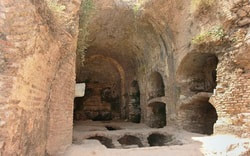 According to rumour, before the acceptance of Christianity as an official religion, seven young men fled from Ephesus in the 3rd century and took refuge here. They sealed up the cave and fell asleep, and were woken up 200 years later by an earthquake which broke the seal. When they awoke and walked into the town, they realised that Ephesus was now an official Christian city. It was deemed to be a miraculous event, and when the young men died they were buried in the same cave, which is now a Byzantine-era grotto. The adjacent building is named after them and has a large monument, many rock-engraved tombs, two churches and catacombs. 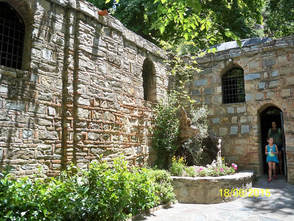
Beyond Ephesus and on Bulbul Dag (mountain), 8km southwest of Selcuk, the monument is believed by some to be where Virgin Mary died, and for some where she lived almost the last decade of her life here at Bulbul Dag which surrounds Ephesus Ancient City with the City Walls built over it.
The Chapel today is visited by Christian and Muslims from all around the world.
Discovery of the Chapel
The small stone house is now a chapel today, and probably dates back to the 4th century AD, although the foundations are thought to be 1st century.
It was not until a German nun, Catherine Emmerich (1774-1824) claimed that she had visions of Mary living in ‘a small, stone house’ in even though the nun had never left Germany. Anna Catherine Emmerich described the area as she was present here giving the smallest details such as the Pine Forest and the Olive Groves that surround the House.
According to the Nun, the House was overlooking to the Aegean Sea and close tothe Ancient Roman City of Ephesus. And she mentions about a Spring water source that runs via the Valleys that lead to Ephesus. After Anna Catherine Emmerich died, it took about 60 year for her visions to be discovered in a book by a Priest around 1890. In 1891, 3 Priests discovered the exact location as it was mentioned in the Book that covers the Visions of Anna Catherine Emmerich.
If you are looking to book a Private Ephesus Tour including The House of Virgin Mary You can click here to Contact Us
Biblical Background
In the Gospel of John, The Crucifixion Section has an additional paragraph that Jesus says "Mother, here is your son, behold thy son. And son here's your Mother behold thy mother."
These words were from Jesus to Mother Mary and St. John the Evangelist. From here we can understand that St. John and Mother Mary were clearly entrusted to each other. And many scholars agree that St. John spent a remarkable portion of his life in Asia Minor hence nearly %85 of Book of Revelation is written from/to the cities in Asia Minor around Ephesus. There is also a very important Church (one of the largest of all Pilgrimage Churches ) near Ephesus named after St. John. So if John the Evangelist was around Ephesus before he was exiled to Patmos Island, he must have taken Mother Mary with him during that period. Relation in Early Christianity
After Christianity was accepted as the Official Religion in 396 AD by Eastern Roman Empire, a series of Ecumenical Councils were convened to decide the main doctrine that the Empire will follow.
Nicaea Council was the First one and mainly the bishops participated on Nicaea Council tried to find an answer to the Nature of Christ. The main Question was "Does Jesus have only Divine character? " or "Does Jesus have both human and Divine Character?" The answers were vague but they still stuck to the second idea. And in the 2nd Council was held in Ephesus in 431. And the one of the main questions was if Jesus is both Divine and human, then Mother Mary is the Mother to which of them? Is she the Mother of Christ the Human (Christokos)? or Is she the Mother of God (Theotokos)? First time in Christian History Mother Mary was titled as Theotokos, the Divine Motherhood of Mary was officially crowned to her at Ephesus. This historical fact also relates Mother Mary with Ephesus.
This Ecumenical Council was held at Church of Mary in Ephesus, on our Private Tours of Ephesus our visitors can get a chance to visit this spot if they requested to their Tour Guide for Ephesus beforehand.
You can click here to get more information about this Council Church. Papal Visits
After the discovery of the Chapel's foundations in 1891, The Balkan Wars were followed by Worl War I, so nothing much could have been done.
Post World War 2 period, the ruined Chapel was reconstructed in 1959 by the Christian Community in Smyrna (Modern day İzmir). Around Mid 60s the community decided to issue an official invitation to the Papacy and in 1967 Pope Paul VI paid a visit to the Area, this was followed 12 years later by John Paul II and lastly in 2006 by Pope Benedict. The Use of the House Today
Today there is an Outdoor Mass Facility beside the Church and also an Indoor Monastery where 5-6 Nuns and Priests live here year around.
The Feast of Assumption, on August 15 is celebrated here by the Orthodox Greeks, and Mass is held daily. The church can only be accessed by car, as no public buses come through the dense forest surrounding it. 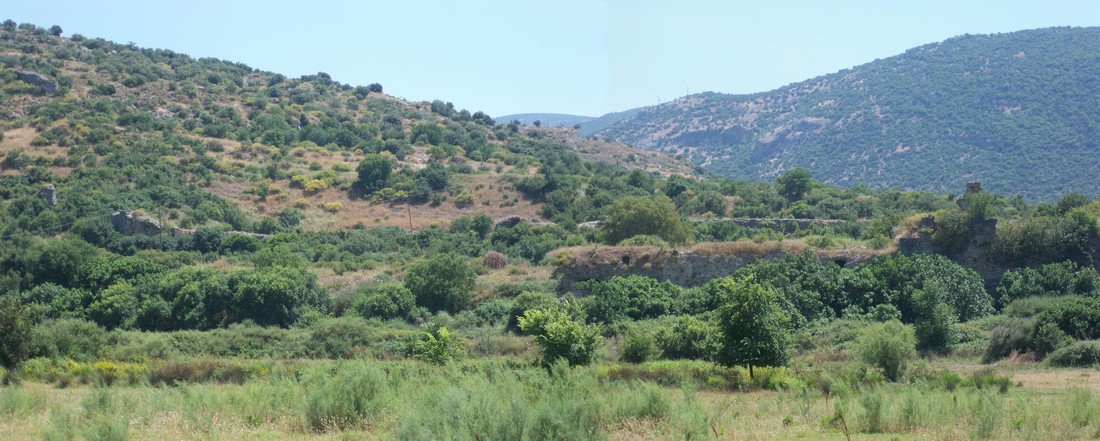 Soon after the entrance to the site are the ruins of Vedius Gymnasium, which was built by a wealthy local businessman in the late 2nd century, in the name of Vedius Antonius. It is a magnificent structure, built as a venue for sporting and cultural education and contains exercise fields and covered rooms, baths, changing rooms, a courtyard and ceremonial room in the centre. To the south is the Stadium, where races, games, and Olympic events took place. 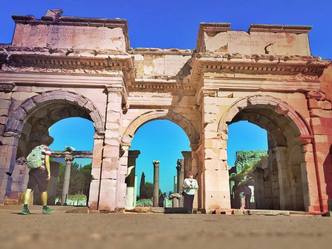 Gate of Mithridates & Mazeus at Ephesus Gate of Mithridates & Mazeus at Ephesus
This Gate which was the south entrance to the mercantile Agora was built by 2 slaves freed by Emperor Augustus in 3 BC.
The inscriptions on top of the Gate, which you can see from in front of Celsus Library indicate Mazaeus and Mithridates the Two freed slaves wished honor the Imperial family by building the structure.
This Gate provides some nice shady spot for tourist groups visiting Ephesus City in the heat of summer.
So Most of the Private Ephesus Tour Guides give a chance for a picture break for Celsus Library and set the meeting place to this Wonderful Roman Gate. In that sense the Gate is a life saver for many visitors.
If you are looking to book a Private Ephesus Tour including The Gate of Mithridates and Mazeus You can click here
What amazes me most is that there is almost 150 years time difference between the Gate of Mithridates and the Library of Celsus. The two structures are attached to each other they give such an amazing complete image together with no signs of age difference.
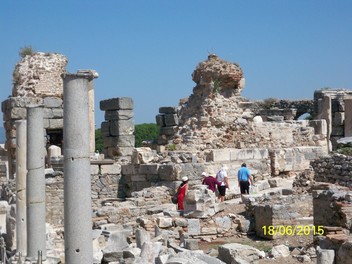 Varius (Skolastika) Baths at Ephesus Ancient City Varius (Skolastika) Baths at Ephesus Ancient City
The Varius Baths was one of the most important places in the social life of Ancient Ephesus.
It was here that the most distinguished families of the city would come. Usually in the afternoons to get cleaned. Often they would bring their servants who would massage and perfume them. When they were finished cleaning up, the bathers would sit and relax for hours talking about current events in the Tepidarium, or warm room.
The Baths had 2 known entrances. One off of Bath's street which runs from the Curetes street up to the top of the Grand Theater of Ephesus.
The other entrance is to the right of the Temple of Hadrian. Below the Baths Western Wall there was a Passage Way which was covered with an arched tile roof where they embedded the earthenware pipes so they could transfer the grey water to the Public Latrines to be used for the constantly running flush system.
If you are looking to book a Private Tours of Ephesus including The Varius Baths You can click here to Contact Us
The floors were heated from underneath by circulating hot air.
A common method of heating in Roman times. The seated statues found in the east corner is that of Skolastika, who paid for the renovation of the building around AD. 400.
The Western side of the Bath is overlooking to the Library of Celsus, and it has a sort of Patio Terrace where visitors of Ephesus who are taking Private Ephesus Tours can take some of the best shots of the Library of Celsus from this location.
 State Baths at Ephesus, Turkey State Baths at Ephesus, Turkey
The partially excavated structure across from the State Agora was the Bath complex.
You can see large bathing rooms on the back of the structure. On the left side was the Calderium or hot water room, with niches for bathing basins and large windows. On the front of the complex, or south-side was a latrine (Click Here for more information about the Public Latrines at Ephesus) and smaller adjoining rooms some of which were used for commercial activity. (Click Here to learn more about the Market Places in Ephesus) There was also a larger hall like a basilica with mosaic floors where people could relax, stroll or engage in physical exercise.
Upper Entrance to Ephesus Site is right across these Baths, so when visitors start their Private Tours of Ephesus, the first standing structure they see is the Triple Arched walls remaining from the Upper Bath Complex.
If you are looking to book a Private Ephesus Tour including The Upper Bath Complex You can click here to Contact Us
Inscriptions also suggest the presence of a Gymnasium from the late Hellenistic period. Gymnasium is a larger complex including some Educational and training partitions added to the Bath Complex.
These Baths were incorrectly identified as the Baths of Varius, for many years.
The Baths of Varius are instead found on the Curetes Street. 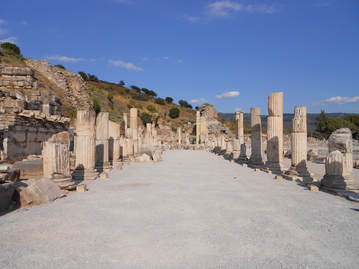 Basilica Stoa at Ephesus Ancient City Basilica Stoa at Ephesus Ancient City
This leveled area, part of the administrative area of Ephesus is one of 2 agoras (or markets) in the Ancient City of Ephesus.
Though not much remains of it at one time it was thought to be surrounded with a portico-like structure and adorned with various monuments.
Parts of 2 entrance gates can be seen in the southeast corner, straight across from the baths and the southwest corner, near the fountain of Laceanus Bassus on the corner of Temple of Domitian. Travelers who include Ephesus Museum in their Private Tours of Ephesus can see perfectly preserved Triton Statues from this particular fountain
The State Agora was surrounded by a Collonaded Alley from its 3 Sides, the 4th Side was left open because it was looking towardthe Temple of Domitian at Ephesus and they didn't want the Collonaded Section to Block the view of the Temple.
If you are looking to book a Guided Tour of Ephesus including The State Agora You can click here to Contact Us
From one of the Long Sides of the Agora, one was attached to the Senate Building tied up to it with a 2 storeyed Colonnaded Stoa. Today visitors can only see the columns from the lower tier of it.
The other Long side opposite the Senate was connected with the Main Cistern of the City where 6 different aqueduct lines would feed the City's Fountains and Baths. (Pollio, Hydreion)
In the center of the State Agora, you will see the foundations of what something was the Temple of ISIS, an Egyptian deity which may have been destroyed by Emperor Augustus. By taking a private tour of Ephesus archaeology museum you can see the Statue of Emperor Augustus which was excavated from this part of Ephesus City.
The Emperor may have ordered its destruction because of his dislike of the Egyptians. 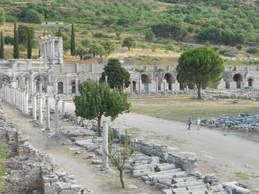 Commercial Agora (Market) in Ephesus Ancient City Commercial Agora (Market) in Ephesus Ancient City
Perhaps the most important of the city's public spaces, the Commercial Agora was in the very heart of Ephesus and served not only as the trading area but also as an important gathering place. Making it a vibrant and bustling area. Various shows and spectacles, sporting competitions and entertainments were held here.
The Commercial Agora had a Square Plan and it was surrounded by a collonaded Stoa from its 4 sides.
Most of the Market places were 2 storeys so this particular one, too. It had 125 sections for shops at each floor so 250 Indoor shops in total. And the Central Outdoor area could accommodate around 500 Stalls, so in total nearly 750 individual merchants could do trade in here.
It was because of this scale Market Places we understand that Ephesus functioned like a Trade Hub controlling the Trade in the Mediterranean and around Mesopotamia.
The merchandise coming all around the world was traded here from ready to wear clothing to medicine, from slaves to exotic spices to livestock.
If you are looking for more info on Private Ephesus Tours including The Commercial Agora You can click here to Contact Us
Market in the Bible
It was in here in this very Market where a Biblical incident took place. In the Book of Acts Chapter 19, Bible talks about a Riot in Ephesus.
This Market is the place that Demetrius the Silversmith led the angry crowd towards the Theater of Ephesus chanting "The Great is Artemis of Ephesus"... thinking that the Rumors spread around tell that Apostle Paul is saying that the Gods that they made with their hands were fake, not real. These rumors upset many of the silversmiths and goldsmiths who made their fortune by Golden and Silver Idols of the Goddess. Some says Apostle Paul preached Ephesians at the Theater when this incident took place, but Biblically this is not accurate. Apostle Paul might have thought of going into the Theater to make one of his convincing speeches but he was stopped by his 2 traveling companions Aristarchus and Gacius.
A Water clock and Sundial stood in the center of the square, in much the same way town squares today have a clock.
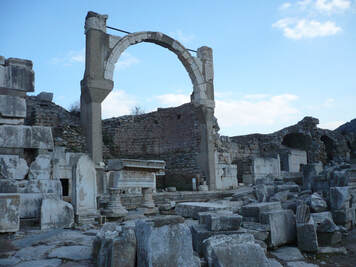 Pollio Fountain in Ephesus, Turkey Pollio Fountain in Ephesus, Turkey
Across the street from Domitian Temple, you'll see the partially restored arch remains of the fountain of Pollio.
This was built around 92 AD. By C. Sextilius Pollio, a rich Ephesian who also financed the building of Basilica Stoa, found in the administration area in the upper part of Ephesus Ancient city.
Various statues adorned this fountain including one of Zeus and the River God Marnas.
A group statue of Odysseus and Polyphemus stood on the basin of the fountain. These statues can be found on display in the Ephesus museum which is located in the town of Selcuk near Ephesus ancient city.
If you are looking to book a Private Ephesus Tour including The Fountain of Pollio You can click here to Contact Us
Right next to the Fountain there was a Crypt Tomb was placed as a final resting place for Pollio himself. It would seem too risky to place a corpse next to a water source but Ephesians figured this out by using Sarcophagus burial system. The bodies were kept in Sarcophagi so that they would be decomposed as fast as they could so they wouldn't have to worry about the epidemics.
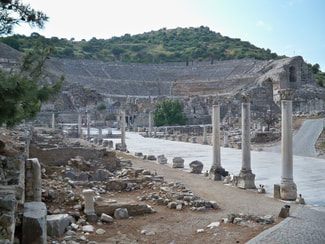 Ephesus Theater Ephesus Theater
The Grand Theater of Ephesus dominates the landscape of Ephesus with the sheer size and magnanimity.
Construction on the Theater began in the 3rd to 2nd Century BC during the late Hellenistic period. Initially it had only 1 tier of seats, it was eventually completed with 2 more tears in Roman Imperial Times. The Theater became a focal point in the life of the city as a place for assembly, dramatic performances, and later on athletic competition.
If you are looking to book a Private Tour of Ephesus including the Theater, then Contact Us by Clicking Here
The Theater seats 25.000, the largest of its kind found in modern day Turkey.
The upper tier of seats was surrounded by covered portico which along with the sloping design of the audience area was vital in creating the necessary acoustical quality of the structure. In the later stages of building, an awning was added on to the portico giving partial covering to the audience. Though no more than the first floor remains the stage house in front of the audience area was three floors high and was fronted with an elaborate facade adorned with statues. This facade faced the audience serving as a magnificent backdrop for performances. The stage House also had a Hellenistic period fountain outside on the north-west corner where the Marble and the Harbor Street meet. 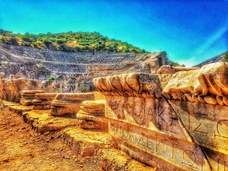 Ephesus Theater in the Bible Ephesus Theater in the Bible
It was in this theater, in reaction to Apostle Paul's propagation of Christianity in Ephesus, and a subsequent burning of articles relating to the cult of Artemis that Demetrius, the silversmith led a crowd in a 2 hour chant, "Great is the Goddess Artemis" this story can be found in Acts 19 of the Bible.
Cave of Apostle Paul in Ephesus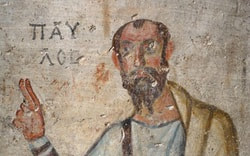 The cave located on Bülbül Mountain, which is one of the mountains that surrounds Ephesus Ancient City, and has been used for cult named Cave of Paulos. Rectangular entrance room covered by vault, probably had been built in Eastern Roman period. An additional is placed south of the cave with 15m length, average 2m width and 2,3m height. This addition is named as Presbyterium. In front of this, there was a barrier and it’s supposed that there is an altar in the middle of the front wall. Vertige of the altar still can be seen. Inside of the cave four layers of frescoes are stacked and these frescoes are dated back since late 4th century till 12th-13th centuries. Oldest fresco layer, is placed on the behind of the eastern wall and, a topic is represented from The Old Testament. A blue tondo with white star is representing the sky figuratively and prophet Elijah is ascending to the sky with his horse carriage in front of it. Elijah put his coat on the ground and his student Elijah has become the prophet instead of him by taking this coat. Mountain in the heaven and four rivers irrigating the earth are representing under this scene. The river names Euphrates, Tigris and Phison can be read today as well. One more layer fresco has been painted in the left part of the entrance on the eastern wall in late 4th or 5th century. The scene of The Prophet Abraham sacrificing his own son Isaac is depicted on this layer. The Prophet Abraham is holding up the knife on his right front and his son is seen on the altar under him. When The Prophet Abraham has looked his back, he saw the hand of the god. This hand is signing to stop during the sacrificing. Frescos of the small niche on the western wall is embossed with flowers and palm tree leaves, but these have been harmed because of the addition which has been built soon. More inside the cave, frescos which are placed on the same wall are representing the most important events of Saint Thekla. There represented three human with Ancient Greek subtitle: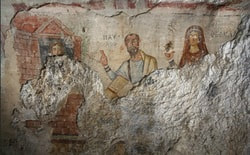 On the right, Saint Thekla, who stays a bit left, is standing on the window who and is listening Saint Paul standing outside. St. Paul is telling from codex while his right hand is up and opened. St. Paul is seen with high forehead which is typical for iconography, sharp beard and brown hair. Behind the Paulus on the right, Thekla’s mother is standing and her right hand is up for warning. Here representing designation of Thekla’s mission, the action that changes his whole life: In Ikonion, St. Paul is preaching about living with diet and chastity. Engaged Thekla’s going out is banned from home. Preach of Paul is being listened excitedly from the window of the next building. After that Thekla breaks engagement without listening his mother’s warning . On north wall there are a few fresco layers in two niches. Front niche on the top layer represents the largest portrait of Jesus. On a little bit older layer a few human with an altar in the center are seen. On the rear niche at least on two layers, Mary sitting in throne, Jesus sitting in embrace and there are single standing humans on left and right sides of him. Saint Georgios 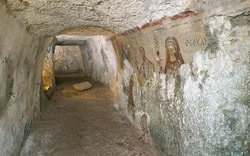 From the youngest fresco layer, very little of them kept on the eastern wall of Presbyterium. Here is a representation of Saint Georgios painted in 12th-13th century. Only yellow Nimbus, armored shoulder, spear and shield are seen. Continually topic changing cult tradition is proven with unusual series of fresco layers. Without knowing clearly the main function of the cave, probably it had to be used as chapel in early Eastern Roman period. Average 300 graffitis calling Jesus and Paul, prove continuous usage of cave from late Ancient Period to beginning of 20th century. Theophanie 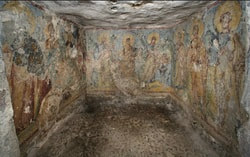 The third and the biggest fresco is placed on Presbyterium wall. The day of reckoning scene Theophanie (a god welcoming) is represented. In the middle golden colored cross shaped Nimbus and Jesus are sitting on the rainbow. On both sides of him white blue clothed two apostles represented from front, are commented as prophet or saint. From both sides turned to Jesus, a little more small drawn three human are coming. These might be the family who has dedicated frescos. The family comes in front of Jesus for wish. On western and eastern wall on the same layer represented Nimbus with woman and man are seen. These are native saints and bishops. There is no more inscription that informed about who they are. 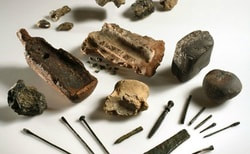 The Earliest Settlement in Aegean Region 0,7 miles diameter wide Cukurici Hoyuk (Mound) is located on the southeast part of Ephesus Ancient city, in a very lush plain surrounded with orchards. The excavations directing that this hillside is dating back to prehistoric periods. And during 1000 years of time, it was settled continuously. Large settlement segments are accumulated in Cukurici Hoyuk. Such settlements are typical from East and Southeast to Europe during both Neolithic and Bronze Ages ( 8th to 2nd Millennium BC.) And in Western Turkey (Western Anatolia) only few of them systematically studied. So far there have been 5 different settlement layers are excavated in Cukurici Hoyuk, which are dating to different periods of time and are in different scales. This case brings up an overture to the age of Cukurici Hoyuk. The Importance of Cukurici Hoyuk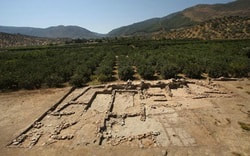 Excavations of Cukurici Hoyuk enlightened the oldest settlement at Ephesus starting from 8200 BC. The studies held so far showes that Cukurici Hoyuk is the oldest settlement. Another geological exploratory drilling made in the slopes of the hillside shows that there may be older settlements. Researching about the expansion of the Neolithic Age lifestyle in Anatolia and Southeast Europe is just covering one aspect of the remarkable issues. The cultural changes in 4th Millenium BC. launched another Age, Early Bronze Age. Cukurici Hoyuk presents significant data to understand the permanent changes of Early Bronze Age and Early 3rd Millennium BC. The function of Cukurici Hoyuk is still not know in the Early Bronze Age, there are still bunch of questions waiting for the answers, which requires a profound study and research. Cukurici Hoyuk is located between Anatolia and Aegean Region Cultures. There are very strong and comprehensive boundaries and relations between these 2 cultures and it is impossible to reckon any remarkable improvement and change for the Prehistoric mankind without taking these relations into consideration. The History of Cukurici Hoyuk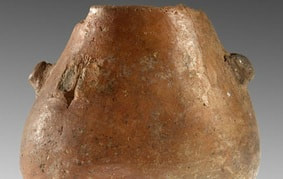 At the end of the 7th Millenium BC (Late Neolithic / Early Calcholithic Age) Cukurici Hoyuk was used as an inhabitancy; the residents with stone basements and mud-brick walls proves that there was settled population over here in Cukurici Hoyuk. In this early phase the food is variable. Firstly wild boar, goat, sheep and cattle were domesticated species. However hunting of rabbit, fox, deer, ox and also mussel collecting are means of food consumption. The production of the high quality ceramic cups, stone gadgets, and generally imported obsidian stone gadgets proves that, the resident people of Cukurici Hoyuk were aware of the technology. There is a destruction and corruption caused by a reason which is still unknown led this early settlement Cukurici Hoyuk to be forsaken. It is known that after the 7th Millennium BC, the first period coming up is 1500 years later 4th Millennium BC. Starting with 4th Millennium BC. there has been a continuous settlement until 2500 BC and in early Bronze Age, Cukurici Hoyuk was abandoned for the 2nd time. In Early Bronze Age there were quite significant and permanent changes experienced in Aegean Region and southeast Europe. By the amendment of the metals and the merchandising of the metal goods, people started getting wealthier. Literally the trade and the wealth put the first Proto-Urban cities on the map. At this very important point of the improvement of the Prehistoric mankind, the role of Western Anatolia (West Turkey) is still uncertain. In this very moment in Cukurici Hoyuk there have been mud-brick walled , gigantic stone based and multi room residential units built. This period of settlements were fatally destructed by an earthquake and have never been built again. The small findings in this area indicates that there is a very remarkable and numerous vivid efficiency in Cukurici Hoyuk. Especially the important point is the production of the copper items: In the process of such products, it is known that the items were formed in the moulds then final shapes were given by hammering. Compared to the previous population, there is a change observed in the consumption habits of the people. In Cukurici Hoyuk, rabbit, fox, wild-boar, deer and fox, bear and various species of birds were hunted animals, while the sheep and goats were domesticated. Cukurici Hoyuk and it's Environment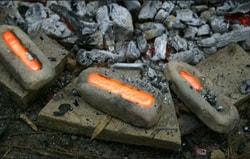 To research about the micro-regional environment of Cukurici Hoyuk, the reconstruction of the Pre-historic region, the exact coastal line, ecological resources and climate conditions are being studied. In the excavation team of Cukurici Hoyuk, there are scientists actively working since 2007 from the fields of Archaeology, Archaeozoology, Archaeobotany, Anthropology, Climatology, Physics, Paleogeography, Geology and Mineralogy. Resource: Translated into English by Tugrul Sokmen from the original Booklet of Austria Archaeology Institute / Ephesus Excavations 2009 /www.oeai.at Original Text: B.Horejs Turkish Translation: Filiz Ozturk  Celsus Library at Ephesus Celsus Library at Ephesus
Here in all its glory is the Library of Celsus, symbol of Ephesus.
Thanks to extensive restoration efforts, the building in its time was one of the greatest in the city, stand in all its form of grandeur. Built over the tomb of the Roman Senator, Tiberius Julius Celsus by his son Gaius Julius Aquila in the year 100 AD as a monument to his father, the building also provided an important public service.
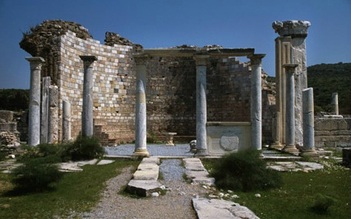 Mary's Church at Ephesus, Turkey Mary's Church at Ephesus, Turkey
Built in late antiquity and the structure central to the early history of Christianity this was the first church to be built in honor of the Virgin Mary and is famous with the Ecumenical Council convened here in the year 431 AD.
The aim of this council was to ratify the fundamental principles of Christianity and to discuss the notion put forward by archbishop Nestorius, that Mary was Christokos, the mother of Christ [in human form] and not Theotokos, the mother of Christ [as God].
If you are looking to Book a Private Tour of Ephesus including Church of Mary You can Click Here
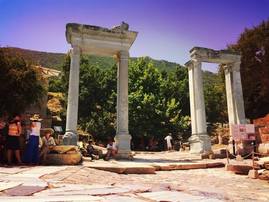 Gate of Hadrian at Ephesus Gate of Hadrian at Ephesus
drian's Gate also known as the New Triodos Gate was built in a central location between the Terrace Houses and the Library of Celsus.
The Building of this spectacular 3 teared structure began during the reign of Emperor Trajan, most probably as a Triumphal monument and was then re-built after being damaged in the great earthquake in 262 AD.
The Gate's grand dimensions suggest that it may also have been used for religious and ceremonial purposes.
The Top tear of the structure reminiscent of the Hadrian Gate built in Athens, a few years later, has 3 openings with the central entry point being the widest to allow both chariots and pedestrians to pass through simultaneously.
If you are looking to book a Private Tour of Ephesus including The Gate of Hadrian you can Click Here
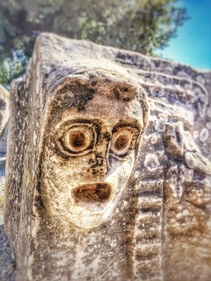 As well as baths a gymnasium was also built near the theater. A place for physical and mental exercise the gymnasiums of antiquity could also be considered an educational establishments school of sorts. It is believed training for the theater was given here. Sporting shows and events to small to be held at the stadium were probably held at the Gymnasium. The Gymnasium also known as the Palaestra took the form of a tribune, most probably with a pool or large water basin dominating the central space. the narrow cubicles on the outer perimeters served as changing rooms. A long large U shaped unit was built by these spaces as a passage way and as area of repose and relaxation. The milestones that served as the road signs of antiquity, informing travelers of the distances between destinations. The unit if measurement employed was the stadia and was equivalent to 185 meters. When a new emperor was crowned the stones were turned over and used a fresh for the sake of economy. Few of these stones have survived to the present day. 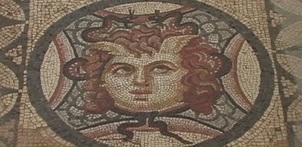 Although the owner, and residence of this house have not been identified, it is clear from the subject matter of the frescoes that those that lived here were lovers of literature, philosophy and the arts. This room is known as the Lion's Room after the mosaic on the courtyard floor featuring a lion attacking a ram. The other floor mosaics in this house feature a Medusa and a bust of Dionysos, both like the lion mosaic remarkably well-preserved. 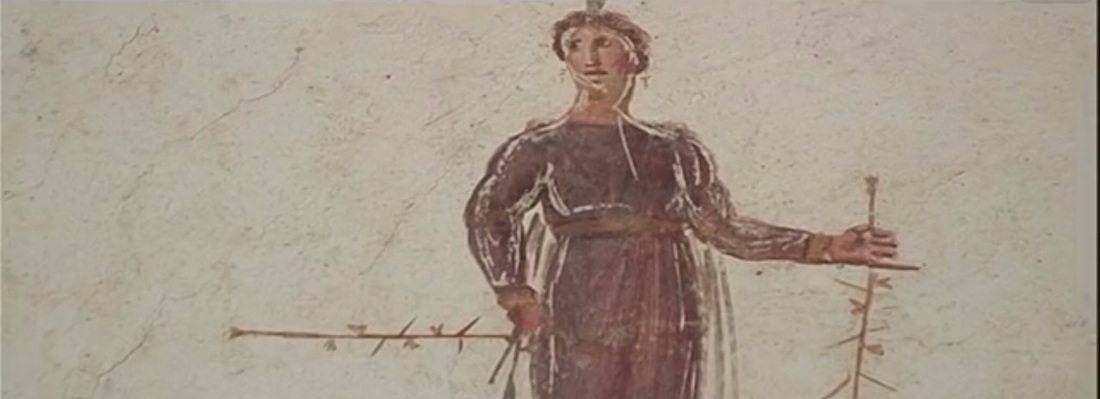 On the walls we see paintings of 9 Muses, as well as depictions of Sappho, the renowned lyric poet of Lesbos, and Chilon [Kaylon] one of the Seven Sages of Greece. 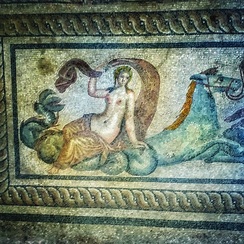 Nereid Mosaic at Terrace Houses Ephesus, Turkey Nereid Mosaic at Terrace Houses Ephesus, Turkey Mosaic features depictions of Triton, son of Poseidon, the Sea Nymphs known as the Nereid and the mythical sea horse known as Hippocampos. The use of reds, greys, yellows and browns and contrasting the light and dark on the off white cream background give the piece great depth and vivacity. According to Mythology A child was born to Poseidon and Amphitrite after their wedding under the sea. However the child was a Merman, half man and half fish as seen in this mosaic. In Art, Triton was generally depicted with the Mermaids known as the Nereid. This particular House is the only dwelling with a kitchen, the heart and pipes are still visible. The room east of the Two Rooms of the north of the Atrium was used as a dining room. The square area in the southwest of the courtyard was the latrine, this latrine which could be used by more than one person at a time, had an arched entrance and both clean water and waste water systems. Parts of the supports that held up the sitting blocks remain intact. Both hot and cold water would flow from the founts in front of the dining room, kitchen and latrine. Nevertheless most houses retained a well or cistern as the water system would often malfunction. 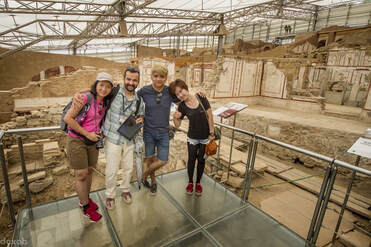 Terrace Houses at Ephesus, Turkey Terrace Houses at Ephesus, Turkey
So far we have mostly looked at structures that served public, official or administrative functions in Ancient Ephesus.
The Hillside or Terrace Houses on the other hand afford as a glimpse into a more private side of life in Ephesus which makes them perhaps the most riveting and poignant of Ephesus' many marvels.
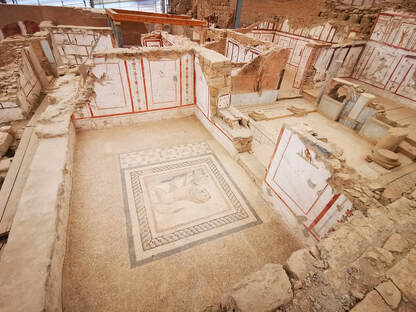 General View of a Roman House at Ephesus General View of a Roman House at Ephesus
Built in the hellenistic style, these houses consisted of a central courtyard surrounded by rooms and living quarters.
The interiors were ornate in nature in contrast to the rather simple exteriors. Most made use of Hypocaust to heat the floors and the walls. 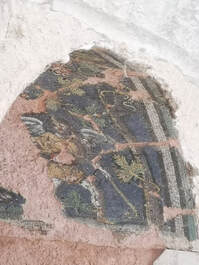 A Religious Scene from a Ceiling Mosaic at Terrace Houses A Religious Scene from a Ceiling Mosaic at Terrace Houses
The discovery of shops and religious structures would suggest that these hillside residences were not only living spaces but were also used for religious and spiritual ceremonies and for production purposes, too.
The residences were in use from the 1st Century BC up to the 7th Century AD. A characteristic of these houses is the aesthetic awareness they display. 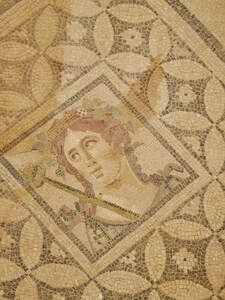 Dionysus, A Floor Mosaic from Terrace Houses Dionysus, A Floor Mosaic from Terrace Houses
The floors were decorated with mosaics, generally of a black and white and geometric design in keeping with the traditional mosaic style of the Roman Era.
However colored mosaics featuring scenes and figures from mythology were also used to beautify the dwellings. To Read More about Nereid & Triton Mosaic please click here. 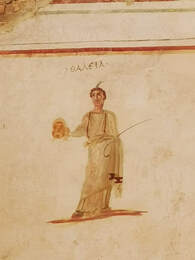 A Fresco Wall Painting at Ephesus A Fresco Wall Painting at Ephesus
The walls were decorated with mythological scenes and characters and with theatrical masks as per the artistic tradition of the period.
Once you get into the interior of these wonderful homes, you can gain an insight of the artistic and aesthetic customs of the time and get to know everyday life in greater details. 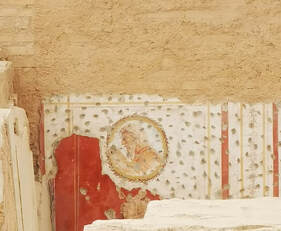 Philosopher Cheilon, one of the Seven Sages of Greece Philosopher Cheilon, one of the Seven Sages of Greece
Hillside Terrace Houses were abandoned as a result of a series of huge earthquakes, but by the late antique period, urgent demands meant they were being re-utilized once more.
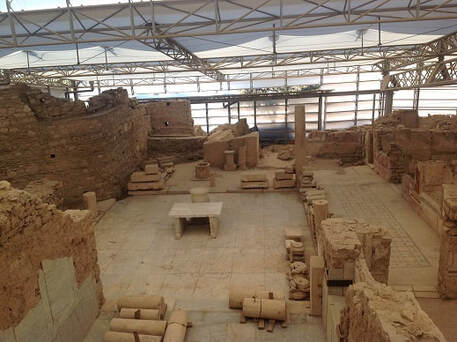 An Atrium Courtyard & Marble Studio An Atrium Courtyard & Marble Studio
TModifications and renovations began to be made to the structures in the 5th Century AD.
And by the beginning of the 7th Century, during the Early Byzantine period, a handcrafts quarter to have been established with many of the houses, converted into Mills, Smithies or Forges. The evidence suggests that this section of the Second Hillside Residence was used as a small marble-cutting studio. |
